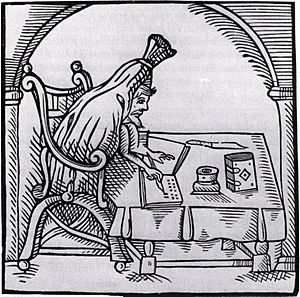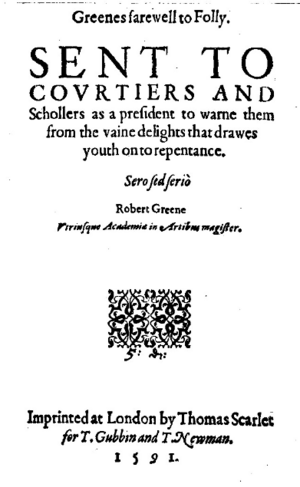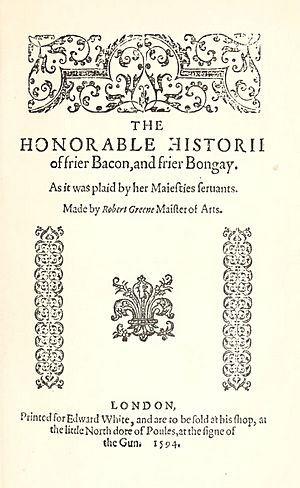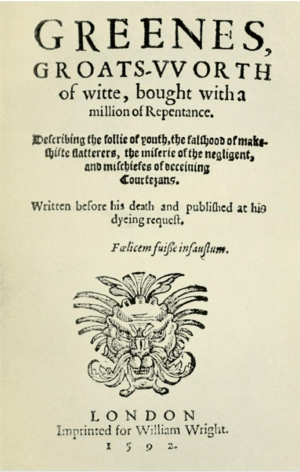Robert Greene (dramatist) facts for kids
Quick facts for kids
Robert Greene
|
|
|---|---|

Woodcut of Greene "suted in deaths livery", from John Dickenson's Greene in conceipt (1598)
|
|
| Born |
probable; Tombland, Norwich
|
| Baptised | probable; 11 July 1558 St George's Church |
| Died | 3 September 1592 (aged 34) London
|
| Nationality | English |
| Occupation | Writer, dramatist, playwright |
Robert Greene (1558–1592) was a famous English writer during the time of Queen Elizabeth I. He is best known today for a book published after he died. This book, called Greene's Groats-Worth of Witte, is thought to contain a hidden message attacking William Shakespeare.
Greene was a popular writer of plays and short books. He was known for criticizing other writers. He was likely born in Norwich, England. He studied at Cambridge University, earning two degrees. After university, he moved to London. He is believed to be one of England's first professional writers. Greene wrote many different types of books, including love stories, plays, and stories about his own life.
Contents
Robert Greene's Early Life
Finding information about Robert Greene's family can be tricky. This is because "Robert" was a very common name back then. "Greene" was also a popular last name.
It is believed that Robert Greene was baptized on July 11, 1558. This happened at St George's Church in Norwich. Greene himself later said he was from Norwich. This date fits with when he started at St John's College, Cambridge in 1575.
His father might have been a saddler or an innkeeper in Norwich. Both of these men left wills when they died. However, neither will mentioned a son named Robert. Greene himself hinted that his father did not leave him any money.
Education and Career Beginnings
Greene probably went to the Norwich Grammar School. But there are no records to confirm this. He started his university studies at St John's College, Cambridge.
His grades at Cambridge were not the best at first. He got his first degree (BA) in 1580. He was 38th out of 41 students in his college. Later, he got his second degree (MA) in 1583. He did much better this time.
Greene later claimed he traveled to Italy and Spain. However, there is no proof that he actually made these trips. Some experts even doubt if he wrote the book where he made this claim.
He also said he married a gentleman's daughter. He claimed he left her after they had a child. He then spent all her money. She supposedly went to Lincolnshire, and he moved to London. But no records of his marriage have ever been found.
After moving to London, Greene became a very busy writer. He published more than 25 books. He became known as "England's first celebrity author." In 1588, he received another degree from Oxford University. This was an honorary degree. After this, his book titles often said he was a "Master of Arts in both Universities."
Greene died on September 3, 1592. He was likely 34 years old. A writer named Gabriel Harvey announced his death. Harvey said Greene died from eating too much pickled herring and drinking too much wine. He also said Greene was buried in "the New Churchyard near Bedlam." But there is no official record of his burial.
Robert Greene's Writing Style
Greene was a very talented writer. He knew many languages and read widely. From 1583 to 1592, he published over 25 books. He was one of the first writers in England to earn a living just from writing. This was very rare back then.
Greene started his writing career with a long love story called Mamillia in 1580. His love stories were written in a fancy style. Two of his best were Pandosto (1588) and Menaphon (1589). He also wrote beautiful poems and songs within his stories. One famous song from Menaphon is "Weep not my wanton, smile upon my knee." It is a lullaby from a mother to her baby.
Later, Greene wrote "coney-catching" pamphlets. These were stories about tricksters and criminals. They told how these bad guys cheated young gentlemen out of their money. Greene wrote these stories as if he was a former trickster who had changed his ways. People thought these stories were about his own life. They believed he was writing about his past wild life and his dealings with actors. However, some experts now think Greene made up much of his "bad boy" image.
Greene's plays earned him a spot among the "University Wits." This was a group of talented writers who had studied at university. Other members included John Lyly, George Peele, Thomas Nashe, and Christopher Marlowe.
Greene also wrote several plays. None of them were published while he was alive. His most popular play was Friar Bacon and Friar Bungay. Other plays include The Scottish History of James IV and Alphonsus. He also wrote Orlando Furioso, based on a famous Italian poem.
Some experts believe Greene might have written other plays too. These include John of Bordeaux, The Troublesome Reign of King John, and even parts of Shakespeare's Titus Andronicus and Henry VI plays.
Greene and Shakespeare
Robert Greene is most famous among Shakespeare fans for his pamphlet Greene's Groats-Worth of Wit. This book has a line that seems to be about Shakespeare. The line is "O tiger's heart wrapped in a woman's hide." This line is also found in Shakespeare's play Henry VI, Part 3.
Here is the famous quote from Greene's pamphlet:
... for there is an upstart Crow, beautified with our feathers, that with his Tygers hart wrapt in a Players hyde, supposes he is as well able to bombast out a blanke verse as the best of you: and being an absolute Johannes fac totum, is in his owne conceit the onely Shake-scene in a countrey.
In this quote, Greene seems to be complaining about an actor. This actor, he says, thinks he can write plays as well as university-educated writers. Greene uses a quote that appears in Shakespeare's play. He also uses the unique term "Shake-scene" to describe the actor. This term was never used before or after Greene's writing.
Some scholars think that someone else might have written parts of Groatsworth after Greene died. They believe this person wanted to make money from a dramatic story about Greene's death. However, other experts believe Greene wrote the whole thing himself. They think he attacked Shakespeare because Shakespeare might have interfered with one of Greene's plays.
Some people, like Stephen Greenblatt, think Greene might have been the inspiration for Shakespeare's character Falstaff. Greene's famous quote also inspired the title of a 2016 TV show about Shakespeare's life, called Upstart Crow. Greene is even a character in the show.
Some Prose Works by Robert Greene
- Mamillia: A Mirror or Looking-glass for the Ladies of England (1583)
- Mamillia: The Second Part of the Triumph of Pallas (1593)
- The Anatomy of Lovers' Flatteries (1584)
- The Myrrour of Modestie (1584)
- Arbasto; The Anatomy of Fortune (1584)
- Gwydonius; The Card of Fancy (1584)
- The Debate Between Folly and Love (1584)
- The Second Part of the Tritameron of Love (1587)
- Planetomachia (1585)
- An Oration or Funeral Sermon (1585)
- Morando; The Tritameron of Love (1587)
- Morando; The Second Part of the Tritameron of Love (1587)
- Euphues: His Censure to Philautus (1587)
- Greene's Farewell to Folly (1591)
- Penelope's Web (1587?)
- Alcida; Greene's Metamorphosis (1617)
- Greenes Orpharion (1599)
- Pandosto (1588)
- Perimedes (1588)
- Ciceronis Amor (1589)
- Menaphon (1587)
- The Spanish Masquerado (1589)
- Greene's Mourning Garment (1590)
- Greene's Never Too Late (1590)
- Francesco's Fortunes, or The Second Part of Greene's Never Too Late (1590)
- Greene's Vision, Written at the Instant of his Death (1590?)
- The Royal Exchange* (1590)
- A Notable Discovery of Coosnage (1591)
- The Second Part of Conycatching (1591)
- The Black Books Messenger (1592)
- A Disputation Between a Hee Conny-Catcher and a Shee Conny-Catcher (1592)
- A Groatsworth of Wit Bought with a Million of Repentance (1592)
- Philomela (1592)
- A Quip for an Upstart Courtier (1592)
- The Third and Last Part of Conycatching (1592)
Verse by Robert Greene
- A Maiden's Dream (1591)
Plays by Robert Greene
- Friar Bacon and Friar Bungay (around 1590)
- The History of Orlando Furioso (around 1590)
- A Looking Glass for London and England (with Thomas Lodge) (around 1590)
- The Scottish History of James the Fourth (around 1590)
- The Comical History of Alphonsus, King of Aragon (around 1590)
- Selimus (around 1594)
See also
 In Spanish: Robert Greene (escritor inglés del siglo XVI) para niños
In Spanish: Robert Greene (escritor inglés del siglo XVI) para niños




